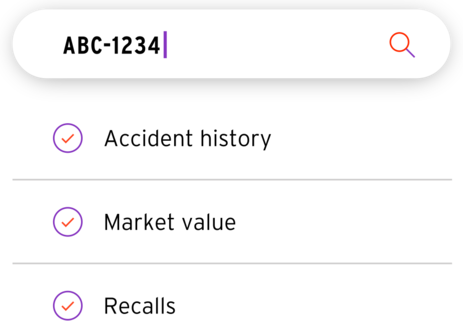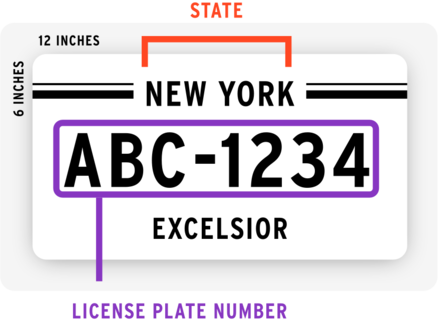What info can you find with a license plate search?
The results of our license plate search can provide information that can be difficult to find in one place. Our license plate data is sourced from federal agencies like the NHTSA, NMVTIS, and state-level government and DMV agencies, alongside leading third-party automotive industry sources like J.D. Power. Because state agencies and industry groups maintain databases of significant events in a car's lifespan (such as accidents or theft), connecting an individual vehicle to those databases via its unique license plate may uncover vehicle-specific information, including:
Equipment and trim specifications
Sale history
Publicly accessible license plate lookups like Bumper could reveal a wealth of information to help you decide if buying or selling a vehicle is the right move.

What is a license plate lookup?
A license plate lookup is a search performed by entering a vehicle's license plate number into a search tool. It can then return information specific to that vehicle. If you see a car that interests you, a license plate search may be preferable to a VIN lookup simply because it's easier to locate and see.
A license plate search can also return more specific information than a simple make and model search. License plates are unique to individual vehicles whereas there are many examples of a given make and model.


How can a license plate search help you?
A license plate lookup can put valuable information in your hands to help you make a decision about buying or selling a vehicle. Depending on what the search reveals, it could help ensure you receive maximum value as both a buyer and seller.
Say for instance that you see a car for sale. A license plate search may provide a market value for the vehicle, so you can contact the owner with a reasonable price offer. Alternatively, the search may reveal that the car's title has a flood damage brand—a sign that pursuing it may not be worth your time.
As a seller, a search can provide peace of mind for your buyer. A full vehicle history report can assure them that there's been no damage to back up maintenance records, as well as reinforce that your asking price is reasonable. Estimated ownership costs also provide a fuller picture of the true cost of the vehicle, heading off any potential angry phone calls should the buyer need to replace an expensive part in the future.
What is a license plate?
In addition to VIN lookups and make/model searches, a license plate lookup is another popular way to learn more about a vehicle. Because license plates are publicly displayed, they're often easier to spot than VINs. Read on to learn more about how a license plate search can work for you.
License plates, also referred to as tags and vehicle registration plates, serve as indicators to government officials and law enforcement that a vehicle is registered in the state listed on the plate. Because the plate is linked to an individual car, a license plate lookup may reveal a lot about the vehicle.


Who issues license plates?
In the United States, license plates are issued by the state or territory department of motor vehicles (DMV). The only federally issued plates belong to cars owned by the federal government and visiting foreign diplomats.

How do license plate formats work?
License plate formats can vary greatly from state to state. Above all, the goal is to use a format with enough alphanumeric character combinations to ensure that every vehicle in the state can have a unique number.
Less populous states may be able to accommodate motorists with simple numeric formats up to six digits. Most license plates, however, tend to use six- or seven-character combinations of letters and numbers. For smaller states, a seven-character format provides the flexibility to incorporate codes for things such as counties and expiration dates.
Even printing methods vary; most states currently emboss or press the registration number into the plate, but digital printing (or "flat plate" technology) is increasingly popular. About the only thing that North American (including Canadian) license plates have in common is size: In 1956, the US and Canada agreed that all license plates would measure roughly 6x12".


Do you need front and rear license plates?
Most states and territories require passenger vehicles to display both front and rear plates. There are some that only require rear plates, however, mostly throughout the South and Rust Belt.
States that require front and rear license plates:
Alaska, California, Colorado, Connecticut, Washington D.C., Hawaii, Idaho, Illinois, Iowa, Maine, Maryland, Minnesota, Missouri, New Hampshire, New Jersey, New York, North Dakota, Oregon, Rhode Island, Texas, Utah, Vermont, Virginia, Washington, Wisconsin.
States that only require rear license plates:
Alabama, Arizona, Arkansas, Delaware, Florida, Georgia, Indiana, Kansas, Kentucky, Louisiana, Michigan, Mississippi, New Mexico, North Carolina, Ohio, Oklahoma, Pennsylvania, South Carolina, Tennessee, West Virginia.
States that require both plates, with exceptions:
Massachusetts, Montana, Nebraska, Nevada, South Dakota, Wyoming.


What are vanity plates?
Vanity plates are license plates printed with a custom serial, usually for an extra cost. They are available in all 50 states and the District of Columbia, though as with most license plate formats the requirements vary. While Maine will not censor any vanity plates provided the serial doesn't promote hate or violence, most states have rules banning their definition of profanity. Virginia issues the highest concentration of vanity plates by any state, accounting for 10% of all US vanity plate registrations.






